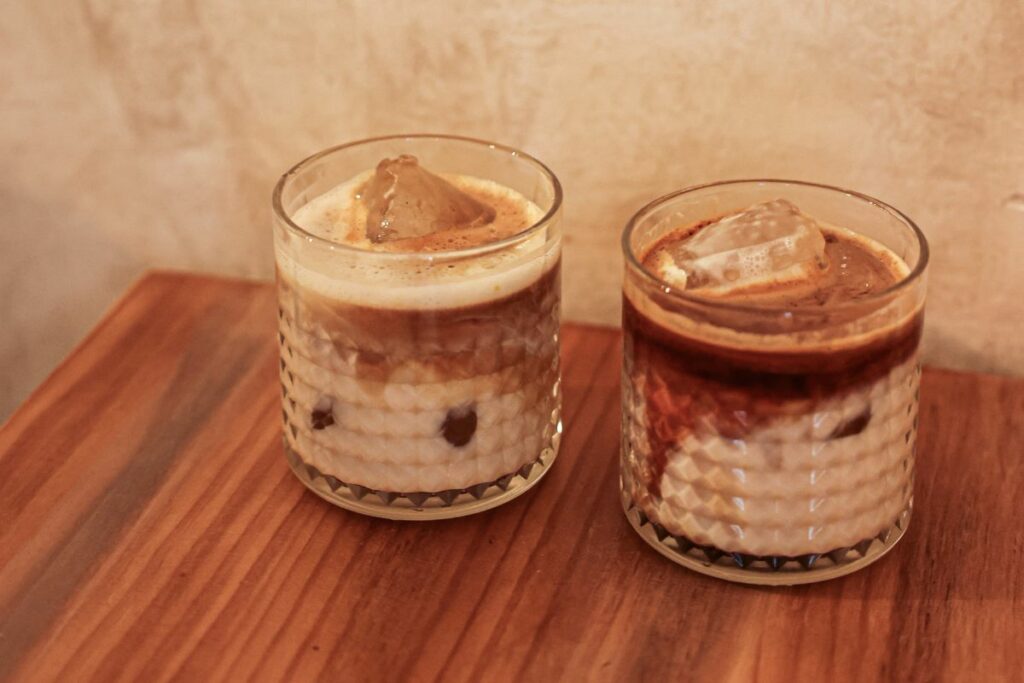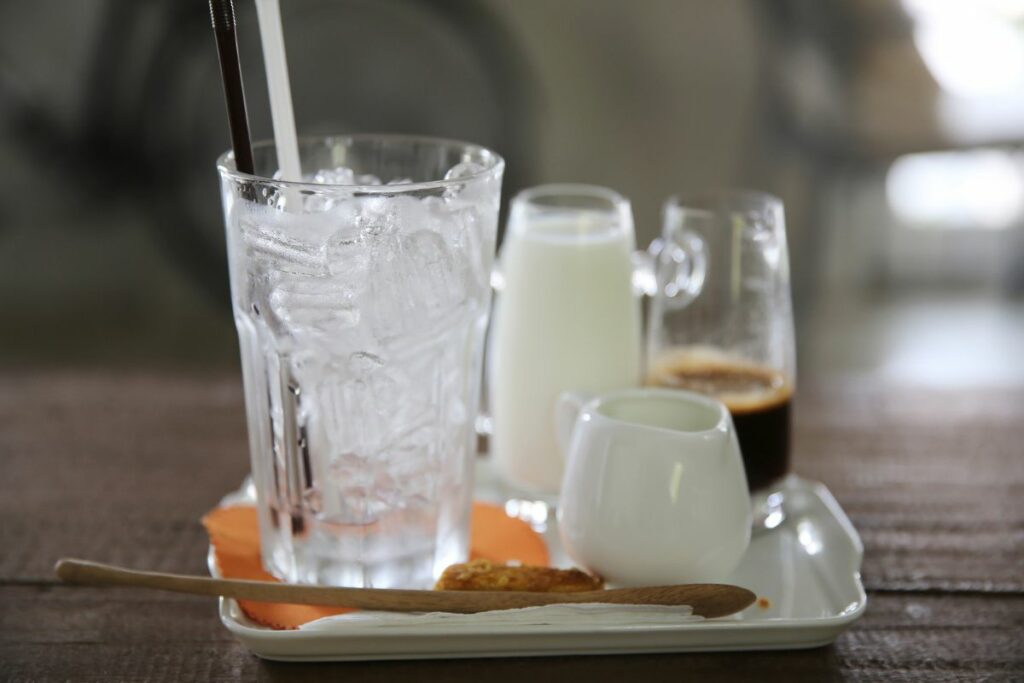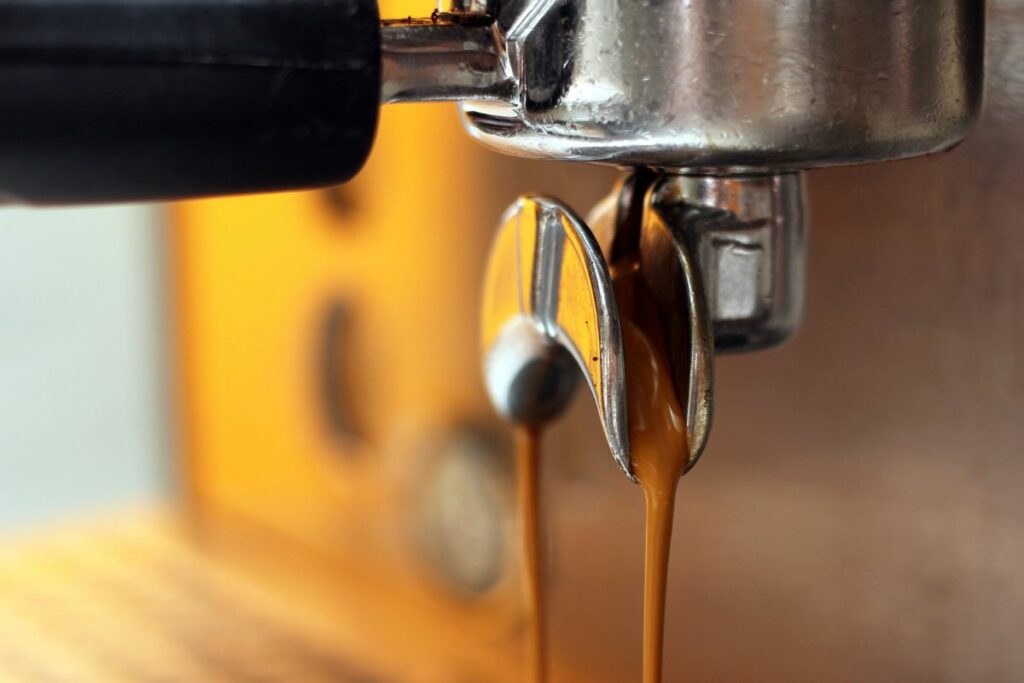The Spanish Latte is a third wave of coffee movement innovation derived from the Spanish café con leche. A combination of espresso with milk, there are two kinds of milk involved – regular milk and condensed milk. This specialty latte may be served hot or cold.

Table of Contents
Origins of the Spanish Latte
A typical Spanish latte from a third-wave coffee joint will have a strong and robust espresso made from high-quality beans, and large amounts of milk and topped with microfoam or froth. Sometimes it will have a dusting of cinnamon powder or chocolate sprinkles on top. Depending on where you order it from, a Spanish latte may be further sweetened with sugar or sweet syrup to suit the preference of younger customers, but you can definitely have it without the added sugar.
The origin of the Spanish Latte is unclear. It may be a version of a Café Bombon from Spain, which also uses sweetened condensed milk on a 1:1 ratio, or similarly, the Cuban Havana Latte. According to Faisal and Osamah, forerunners of the burgeoning Saudi Arabian coffee culture, it is likely a derivative of intensely strong yet sweet Vietnamese cap he sua da.
The Spanish lattes’ popularity is spreading far and wide, across the globe from Europe to Asia. In Saudi Arabia, the Spanish Latte is even paving the way for specialty coffee establishments to penetrate mainstream markets.
Difference Between Spanish Latte and Latte?
A Spanish latte is decadent, bursting with a creamy texture and a sweet, milky taste. In Spain, the Spanish aren’t familiar with a Spanish Latte. If you’re looking to order an espresso with milk in the Iberian Peninsula, or any Latin American country for that matter, order a latte or café con leche. Both coffees are espresso based combined with frothed or steamed milk. If you want a coffee with condensed milk, you’ll want to order a Havana Latte or a Leche y Leche.
There are many permutations of the Spanish Latte across the globe. Whatever name it is called in whatever part of the world it is consumed, the defining characteristic remains the same – it’s made of really strong coffee and condensed milk.

Café con leche – This is first on the list because it’s arguably the inspiration behind the Spanish latte, hence the “Spanish” in the name. Café con leche literally translates to coffee (café) with (con) milk (leche). This combination is equal parts (1:1 ratio) espresso to milk, which is an essential part of a Spanish breakfast along with pastries and orange juice.
Café Bombon – Café Bombon originated in Valencia Spain and immediately became popular in the rest of the country and Latin American states. ‘Bombon’ translates into English as confection, or bonbon. It is a sweet coffee drink made from a 1:1 ratio of espresso and condensed milk, though some variations use less condensed milk.
Cà phê sữa đá – Vietnamese coffee is dark roasted Robusta, slowly dripped through a metal filter (called a phin filter), then poured over condensed milk and served in a short clear glass. The cold version is usually served with lots of crushed ice.
Kopi Susu Panas – A strong brewed coffee poured over condensed milk; it’s a staple in Malaysian cafes.
Cortado Leche Leche – Also known as Leche y Leche, this is one of the specialties of the Canary Islands. It’s a cortado with condensed milk at the bottom of the cup.
Gafae Yen – This is a Thai Iced coffee that mixes coffee, evaporated milk, and condensed milk. Thai coffee beans also usually have non-coffee additions that change the flavor, like soybeans or corn.
Havana Latte – Cuba’s espresso and condensed milk version of the traditional latte.
These coffee concoctions are different based on their espresso-to-milk ratio or coffee-to-milk ratio.
A Spanish latte is essentially a café con leche with the addition of sweetened condensed milk. Unlike a latte, which is 1/3 espresso, and 2/3 steamed milk, the Spanish latte is 1 part espresso, and 1 part steamed milk with sweetened condensed milk. It also has a more intense flavor with a stronger caffeine kick compared to a latte. We can definitely taste the difference when we make our own Spanish Latte at home.

Making a Spanish Latte at Home
All great-tasting coffee relies on quality ingredients. Before we get started with making our own Spanish latte, it is essential to know the ingredients and equipment to make it.
Ingredients:
Coffee Beans
The most important thing you will need to make a decent shot of espresso is high-quality, freshly roasted coffee beans that you will grind yourself. A Spanish latte is made with espresso coffee beans or darker roast coffee beans. These types of roasts will be your best option to pull nice, strong espresso shots. These types of roasts are also important because Spanish Lattes are sweetened with condensed milk. You want a balance of flavors in your cup.
If you don’t have these on hand, feel free to use any kind of ground coffee that you are personally accustomed to.
Water
Water is pretty obvious but the type you use can impact the flavor of your coffee. If the water from your tap smells or tastes off, best to use filtered or bottled water. Using distilled water is not ideal for making coffee because it is purified and cleansed for clinical purposes, unless you have a Third-wave water packet.
Alternatively, stale water can also be an issue if you keep water in your espresso machine’s water reservoir. Some coffee aficionados drop a pinch of salt into stale water to freshen it up. Heat up water in a pot or kettle on the stovetop until boiling point (200 F / 93 C), then let it rest before pouring it into your coffee.
Espresso
Pulling a great espresso shot requires technique and lots of practice. If you’re not used to your beans, do a couple of trials until you reach an espresso shot that has a flavor level to your liking. As with every other coffee you make, ensure that you have high-quality freshly roasted beans that you can grind yourself, fresh-tasting tap or filtered water, and a good machine. You need the right equipment to make good espresso; it’s not one size fits all. Determine your needs and preferences and look into espresso makers, if that’s your preference.
Condensed Milk
Condensed milk is cow’s milk from which 60% of its water was removed, and the rest was preserved by adding sugar. It’s widely available at any grocery store. Make sure to choose a brand with only a few ingredients – mostly milk and sugar. If condensed milk has a lot of additives, you know it’s cheap and ultimately not good for you.
The default of these types of coffee is sweet. If you’re counting the calories or do not have much of a sweet tooth, bring down the sweetness by reducing your condensed milk to 1 – 2 teaspoons.
Milk
Most milk will be suitable for use in this latte. The important factors to consider are the amount of protein and fat that they have in them. Respectively, these two factors are what allow the foam-like consistency and additional flavor it will lend to your cup of coffee.
Whole milk is the best option, but you may use skim or non-dairy alternatives such as oat milk, almond milk, cashew milk, or macadamia nut milk.

Equipment:
Coffee Grinder
Most coffee virtuosos will say that the most important equipment you will need for making delicious coffee is a good grinder. Grinding your own beans before making your cup of java warrants the best flavor. If you don’t have one yet, a consistent grind, ease of use, and affordability are some of the factors you will need to consider when looking for one.
Grind your coffee beans to fine or superfine to get the right consistency for the espresso brewing method. As a general guidepost, it should be coarser than sand but not so fine that your machine won’t be able to push water through the portafilter. Approximately 30 seconds using a burr grinder will do.
Espresso Maker
If you have an espresso maker at home or Nespresso, then pull your shot as you normally do. Manual espresso machines are great too, if that’s your cup of joe. Dose, grind, tamp, time, and pull that lever to extract that rich and thick espresso you love.
Alternatively, you can make good shots of espresso using a Moka pot, or an Aeropress. Regular brewed coffee is fine too if that’s your preferred brew, but make it a strong cup to balance out the sweetness.

3 Best Spanish Latte Recipes
The Spanish Latte
Prep Time: 5 mins.
This Spanish latte recipe is creamy and sweet with a double shot of espresso and no sugar added. This is an easy, no-fuss, no-milk-scalding recipe. There are plenty of ways to enjoy coffee; this delicious twist on the Spanish café con leche is definitely one of them. Bonus information on making the iced version can also be found in the recipe.
Sweetened Spanish Latte
Prep Time: 5 mins.
A good espresso is just the beginning. Intense, robust caffeine flavors are sweetened with condensed milk for a truly inspired indulgence. This recipe drizzles the condensed milk as the last step, and then blends using a milk frother or steam wand. This is our current caffeine squeeze. We’re sure you’ll enjoy it as much as we do.
Spanish Latte Recipe (Café con Leche) Recipe at Home
Prep time: 8-10 mins.
Create this super-sippable beverage at home. This recipe scalds the milk instead of just steaming it to make it appropriately emulsified. Rich with condensed milk, it’s a coffee of delicious complexity, not to mention creaminess.